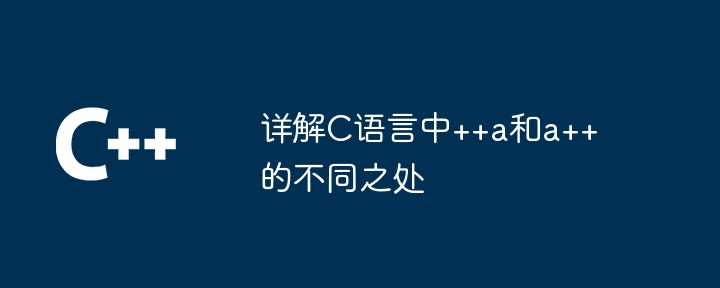 Backend Development
Backend Development
 C++
C++
 Detailed explanation of the differences between ++a and a++ in C language
Detailed explanation of the differences between ++a and a++ in C language
Detailed explanation of the differences between ++a and a++ in C language
C 语言中 ++a 和 a++ 有如下差异:++a 是前缀递增,先递增再返回,而 a++ 是后缀递增,先返回再递增。++a 返回递增后的值,而 a++ 返回递增前的值。根据所需的返回值类型,选择合适的运算符。

++a vs. a++:C语言中的隐秘差异
在C语言中,++a和a++看似相似,但背后却存在着微妙却至关重要的差异。了解这些差异对于编写正确且高效的代码至关重要。
递增运算符的类型
-
++a是前缀递增运算符,它首先递增变量a的值,然后再使用该值。 -
a++是后缀递增运算符,它先使用变量a的当前值,然后再递增其值。
返回值
-
++a返回递增后的值,因此它可以用于赋值或其他计算中。 -
a++返回递增前的值,因此它通常用于创建副作用或跟踪变量的值。
实战案例
案例1:简单递增
int a = 5; // 前缀递增 int b = ++a; // b = 6, a = 6 // 后缀递增 int c = a++; // c = 5, a = 6
案例2:循环计数器
int i = 0;
// 使用后缀递增作为循环计数器
for (i = 0; i < 10; i++) {
// ...
}在这个例子中,后缀递增会在每次迭代循环时返回递增前的值,从而方便地用于计数。
关键要点
- 前缀递增(
++a)首先递增变量,然后返回新值。 - 后缀递增(
a++)首先返回当前值,然后递增变量。 - 根据所需的返回值类型选择正确的运算符。
- 了解这些差异可以帮助避免意外的行为并编写更健壮的代码。
The above is the detailed content of Detailed explanation of the differences between ++a and a++ in C language. For more information, please follow other related articles on the PHP Chinese website!

Hot AI Tools

Undresser.AI Undress
AI-powered app for creating realistic nude photos

AI Clothes Remover
Online AI tool for removing clothes from photos.

Undress AI Tool
Undress images for free

Clothoff.io
AI clothes remover

AI Hentai Generator
Generate AI Hentai for free.

Hot Article

Hot Tools

Notepad++7.3.1
Easy-to-use and free code editor

SublimeText3 Chinese version
Chinese version, very easy to use

Zend Studio 13.0.1
Powerful PHP integrated development environment

Dreamweaver CS6
Visual web development tools

SublimeText3 Mac version
God-level code editing software (SublimeText3)

Hot Topics
 Usage of typedef struct in c language
May 09, 2024 am 10:15 AM
Usage of typedef struct in c language
May 09, 2024 am 10:15 AM
typedef struct is used in C language to create structure type aliases to simplify the use of structures. It aliases a new data type to an existing structure by specifying the structure alias. Benefits include enhanced readability, code reuse, and type checking. Note: The structure must be defined before using an alias. The alias must be unique in the program and only valid within the scope in which it is declared.
 The difference between strcpy and strcat in c language
May 08, 2024 pm 01:03 PM
The difference between strcpy and strcat in c language
May 08, 2024 pm 01:03 PM
strcpy copies a string to another string, while strcat appends a string to another string. The main differences include: different purposes, different processing of dst parameters, and different security considerations.
 What does real mean in c language
May 09, 2024 pm 12:06 PM
What does real mean in c language
May 09, 2024 pm 12:06 PM
real is the data type used to represent double-precision floating-point numbers in C language. It occupies 8 bytes, has a precision of about 15 decimal places, and the range is [-1.7976931348623157e+308, 1.7976931348623157e+308].
 How to use restrict in c language
May 08, 2024 pm 01:30 PM
How to use restrict in c language
May 08, 2024 pm 01:30 PM
The restrict keyword is used to inform the compiler that a variable can only be accessed by a pointer, preventing undefined behavior, optimizing code and improving readability: Preventing undefined behavior when multiple pointers point to the same variable. To optimize code, the compiler uses the restrict keyword to optimize variable access. Improves code readability by indicating that variables can only be accessed by a pointer.
 _complex usage in c language
May 08, 2024 pm 01:27 PM
_complex usage in c language
May 08, 2024 pm 01:27 PM
The complex type is used to represent complex numbers in C language, including real and imaginary parts. Its initialization form is complex_number = 3.14 + 2.71i, the real part can be accessed through creal(complex_number), and the imaginary part can be accessed through cimag(complex_number). This type supports common mathematical operations such as addition, subtraction, multiplication, division, and modulo. In addition, a set of functions for working with complex numbers is provided, such as cpow, csqrt, cexp, and csin.
 What to do if there is an error in scanf in C language
May 09, 2024 am 11:39 AM
What to do if there is an error in scanf in C language
May 09, 2024 am 11:39 AM
In C language, methods for handling scanf function errors include: 1. Check the format string; 2. Check the input; 3. Check the return value; 4. Set the error flag; 5. Use the error handling function; 6. Use custom errors deal with. To prevent errors, use the correct data types, carefully validate input, check return values, and handle potential errors in your program.
 How to implement the power function in C language
May 09, 2024 pm 11:33 PM
How to implement the power function in C language
May 09, 2024 pm 11:33 PM
In C language, there are two ways to implement the exponentiation operation: use the pow() function to calculate the power of the second parameter of the first parameter. Define a custom power function, which can be implemented recursively or iteratively: the recursive method continues to double the power until it is 0. The iterative method uses a loop to multiply the base one by one.
 _What does bool mean in c language?
May 08, 2024 pm 01:33 PM
_What does bool mean in c language?
May 08, 2024 pm 01:33 PM
_Bool represents Boolean type in C language. It is a simple data type that contains only two values, true or false. It is used to represent the results of conditions or logical expressions. It usually occupies 1 byte of memory and can only store true or false. false value.





